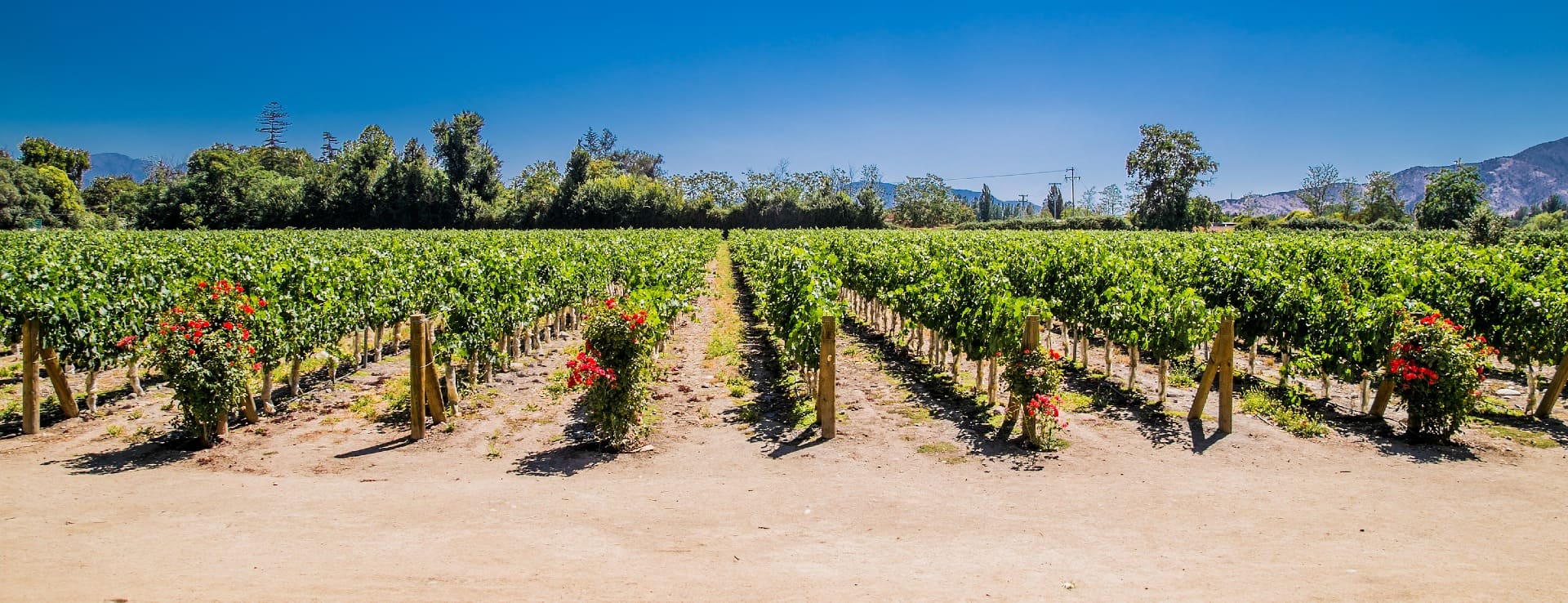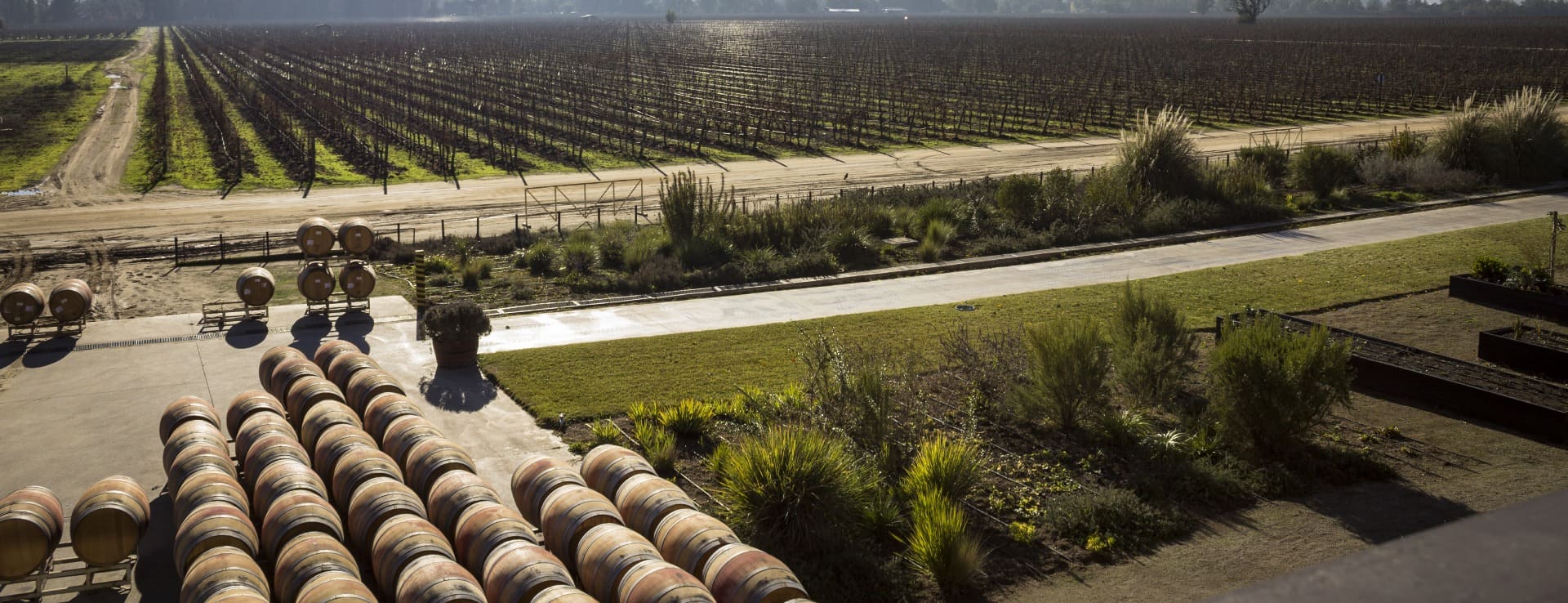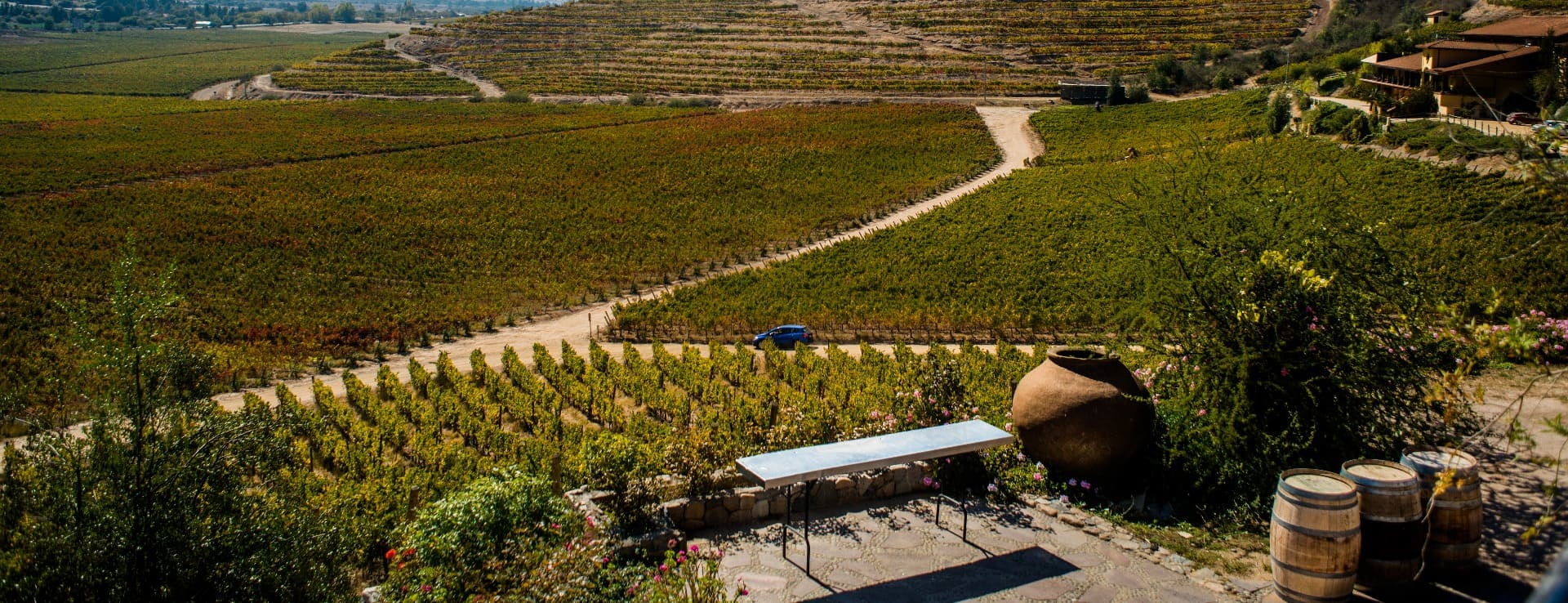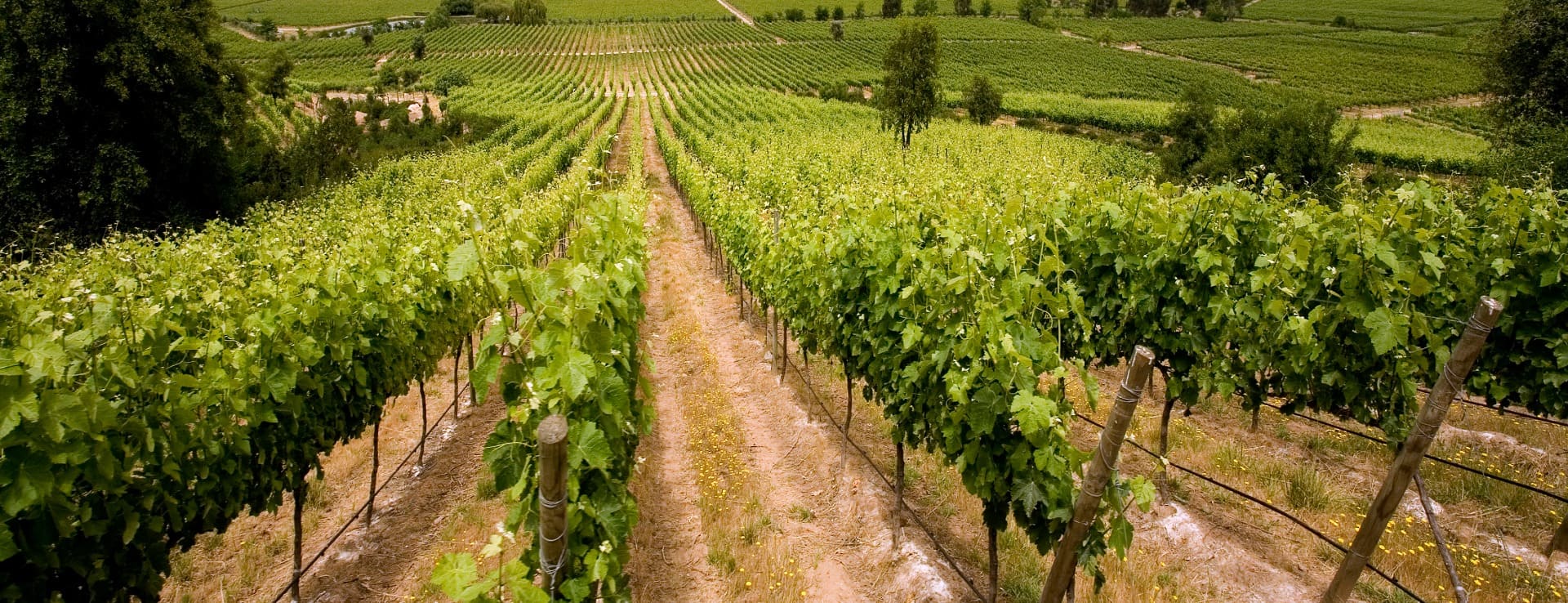Find your winery or vineyard
Infographic of the Denomination of Origin
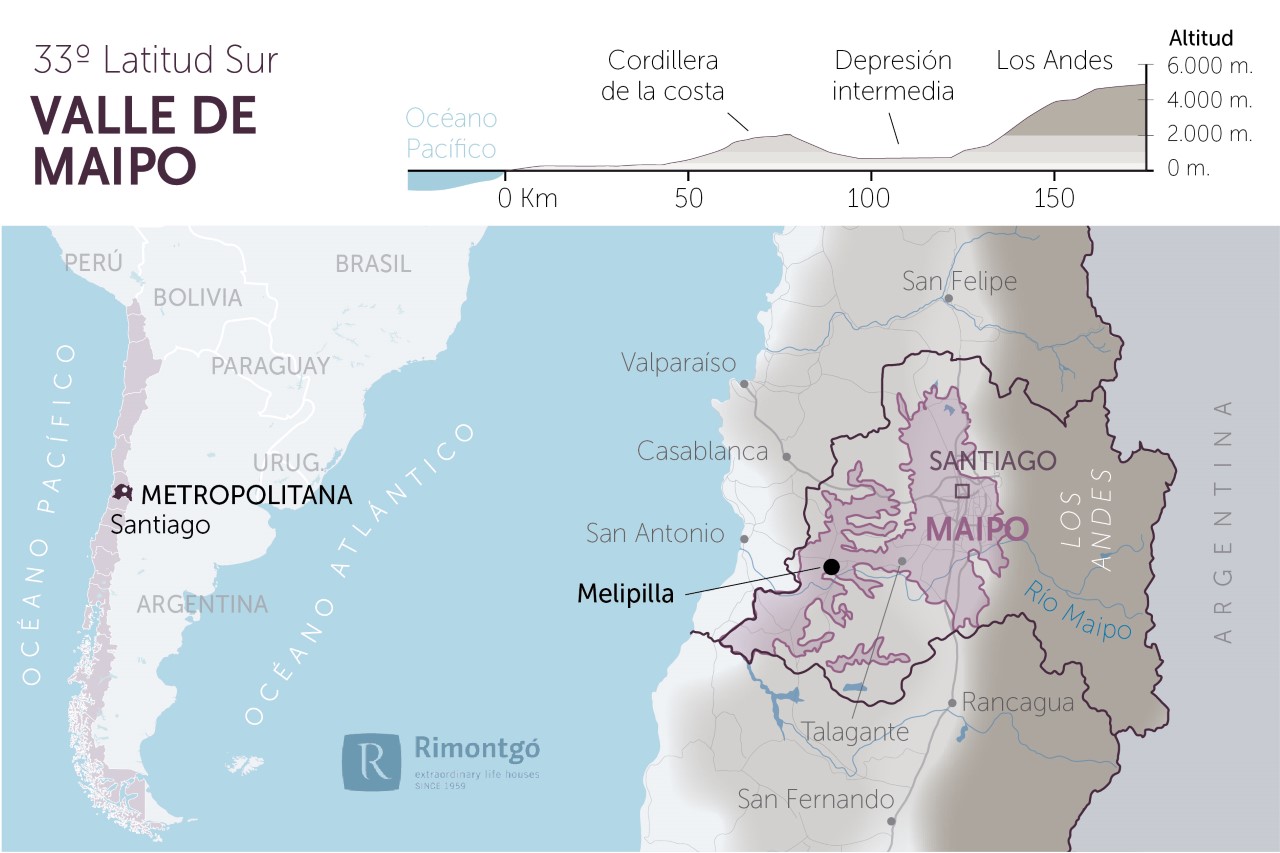
Change to imperial units (ft2, ac, °F)Change to international units (m2, h, °C)
Number of wineries (2017):
62
Total surface area:
13.000 ha32.123 ac
Altitude of the vineyards:
Min: 150m
Max: 800m
Min: 492ft
Max: 2.625ft
Temperature:
Min: 3º
Max: 30º
Min: 37°F
Max: 86°F
Yearly rainfall:
313 l/m229 l/ft2
Designation of origin Valle del Maipo
LOCATION AND HISTORY
The designation of origin Valle del Maipo
owes its name to the Maipo River, whose source is in the Andes, at the foot of the Maipú volcano, at an altitude of 900 meters. The Maipo River has a length of 250 km and flows into the Pacific Ocean. Its geographical configuration gives rise to the Maipo Valley, which, like other valleys located in the central region of the Chilean country, has a noteworthy wine production. The vineyards planted in this location are bathed by the waters of both the Maipo and Mapocho Rivers.
At first, the Maipo Valley was inhabited by the Picunche people, the most northern branch of the Mapuches, who were later conquered by the Incas, whose presence still exists because of the remains of great archaeological value found in their lands.
After the Spanish Conquest, in the 16th century, the Jesuit community settled in the Buin sector and remained here until they were expelled by the Spanish Crown. In 1555 an official document certificates the first wine production in the country, while the first plantations of Cabernet Sauvignon varieties date back to the 19th century, by Mr Silvestre Ochagavía. Therefore, the Maipo Valley became in the Cabernet Sauvignon over the years. This valley has given prestige to the Chilean wine being perfect for the cultivation of Cabernet Sauvignon, Merlot and Carménère thanks to its warm weather.
For nearly 150 years, vine growers started working on wines with a quality seal. The most representative wine-growing areas in the designation of origin Valle del Maipo are the provinces of Santiago, Talagante and Melipilla and, in particular, the subregion of Maipo-Andes is known thanks to its renowned red wines. As a result of the interest in the wine production, the designation of origin Valle del Maipo, receives a large number of tourists year after year belonging to other Chilean regions who gather from February onwards, date in which takes places the grape harvest in the Maipo Valley.
SOILS
From the south of the Aconcagua Valley, the Central Valley reappears in the narrow Santiago basin, formed by the hydrographic basin of the middle course of the Maipo River.
The wine region is divided into three growing areas: Alto Maipo, Central Maipo and Pacific Maipo. Central Maipo, located at approximately 550 m above sea level, is the sunniest area; here red wines take on a more fruity flavour and silky texture. Alto Maipo, in the foothills of the Andes, rises to an altitude of 800 m where the most structured red wines are found. Pacific Maipo is located near the Coastal Range and is characterized by fresh winds, where wines with an interesting acidity like Chardonnay whites are produced.
In addition to the altitude, the Maipo Valley also differentiates the soils between the colluvial and alluvial movements of the sectors closest to the Central Valley.
Analysing from east to west, the first areas to the east are colluvial cones that are located on the slopes of the mountain range, formed by immense rock falls from the mountain range due to gravity, generating deposits of angular material at the foot of the mountain ranges. Climatically the colluvium, being very close to the Andes, generate a high thermal amplitude, due to the cold winds that come down from the high peaks from the sunset and during the night. The colluvial areas are associated with summer months with more moderate temperatures and not as high temperatures as in the north. One of the important climatic characteristics is given by the thermal amplitude that ensures quite powerful red pigmentations (anthocyanidins).
Further to the west, the presence of rivers in this valley such as the Maipo and Mapocho is associated with alluvial soils, formed by the dragging of water and long distances of material from the Andes, which displacement polishes the stones into rounded shapes. The alluvial terraces arise due to the process of runoff from the tributaries and each one of them presents certain and particular characteristics, influencing the characteristics of the wines that will be obtained later. Both the alluvial and colluvial soils are characterised by a rocky soil profile, which imprints its character of low fertility, but with a higher content of silt and clay, especially in its superficial layer. This causes a high drainage and helps to produce balanced wines. The texture of the soils in the Maipo Valley varies between clayey loam, silty-loam and sandy in its Coastal Range vineyards.
CLIMATE
The climate in the Maipo Valley can be classified as Mediterranean, that is, a mild and warm climate. This means moderate temperatures during the summer months with maximums set at 29º and cold winters, but no frosts in the transition from the winter months to spring, an important factor in establishing the cultivation of vines. The average temperature during the summer is 25º while the average annual temperature is established at 15º. In addition to this lack of frost, there is a low level of rainfall in the period closest to the harvest. The influence of the Pacific anticyclone causes rainfall to concentrate between the months of April and September with an annual average of 350 mm. The moderate temperatures enjoyed by Valle del Maipo during the summer are beneficial for the cultivation of varieties such as Cabernet Sauvignon, which occupies the largest extension of land dedicated to the cultivation of grapes in this designation of origin.
The foothills of the Maipo Andes make the climate different from the rest of Chile's wine regions. In this subvalley there is a phenomenon of air convection between the valley and the Andean slope that causes a cooling of the air in spring and summer and a warming in winter and early spring. In addition, it is an area with low relative humidity and great sunshine. This guarantees that the grapes are at the right point of ripeness and are in optimum health, allowing the cultivation of organic vineyards.
TYPE OF GRAPE
Topography in the designation of origin Valle del Maipo makes possible the cultivation of vines at different altitudes. The change in temperature between day and night in the Maipo Valley are highly noticeable. In addition, a weather characterised by short winters and mild and dry summers are factors which favour the commitment for red varieties. From about the 10,000 ha dedicated to vineyards in the Maipo Valley, 8,000ha are planted with red varieties of which 6,400 ha are Cabernet Sauvignon and 1,100 ha of Merlot, while the remaining 2,000 ha are used for white varieties, of which 950 ha are Chardonnay. Far away are found varieties such as Carménère, Syrah, Sauvignon Blanc, Cabernet Franc, Malbec, Petit Verdot and Semillón.
Discover more wineries and vineyards for sale in these wine regions in Chile
Subscribe to our mailing list to receive news about wineries and vineyards.

